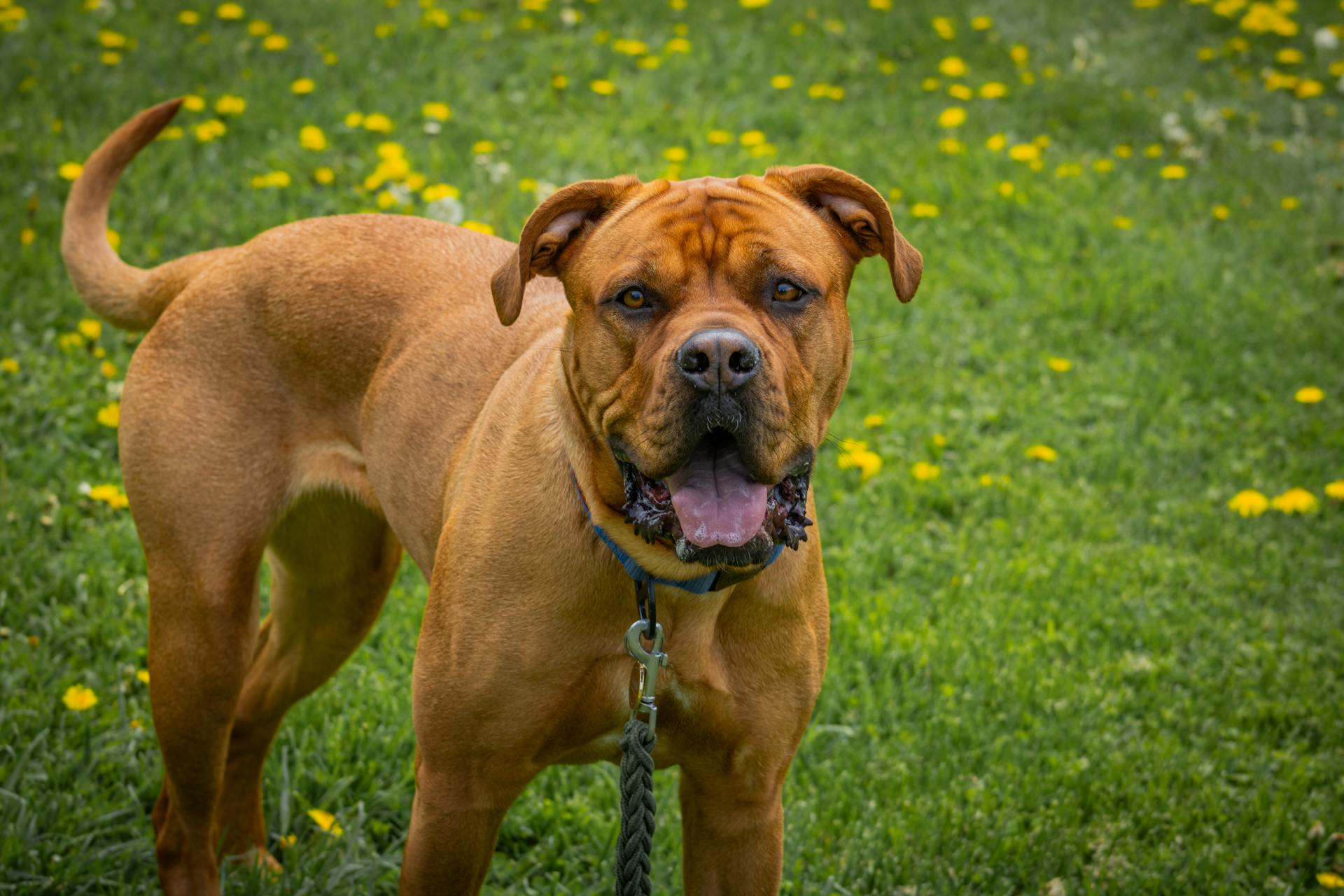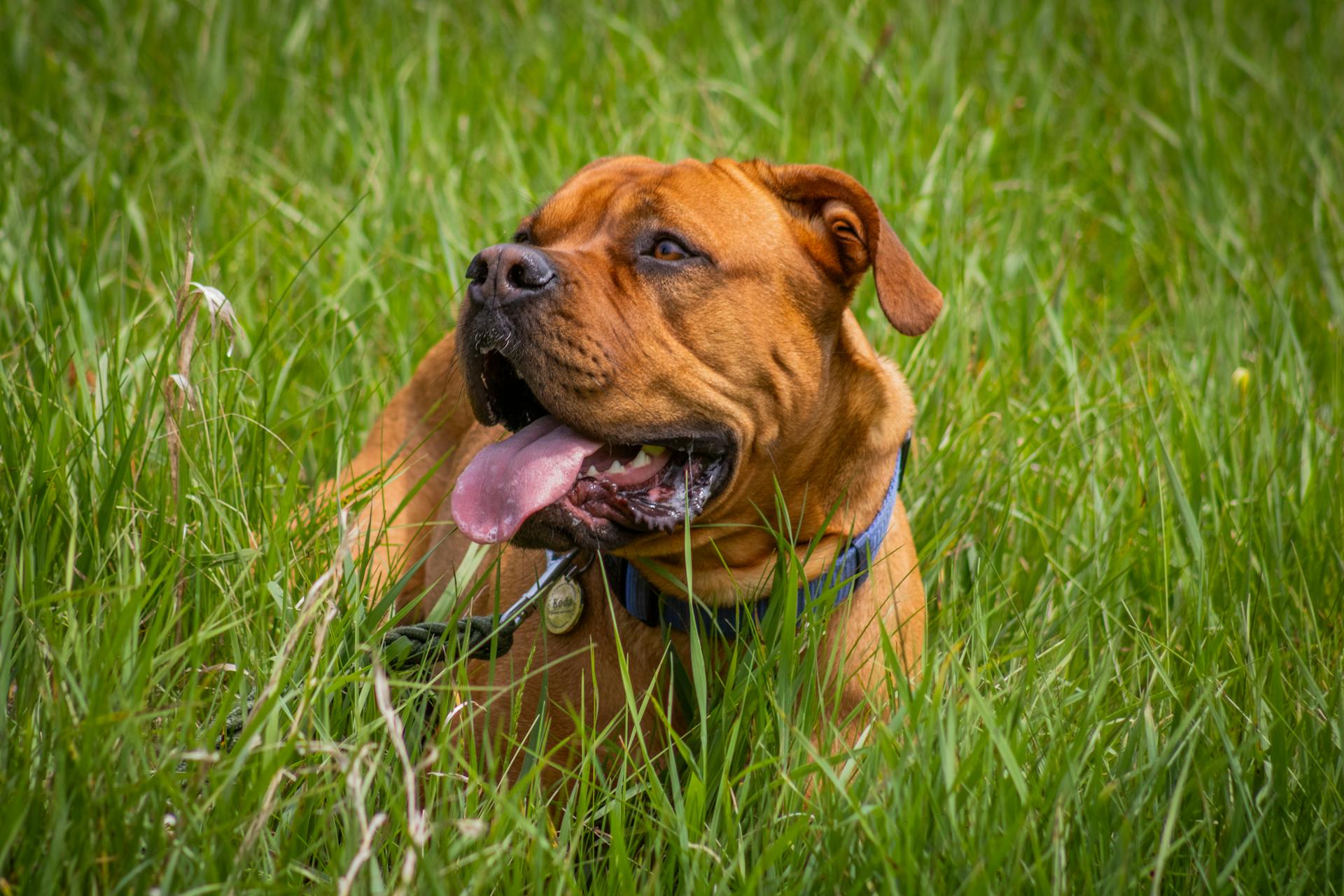
Neapolitan Mastiffs are massive dogs with a short, easy-to-maintain coat that requires minimal grooming.
They can grow up to 26 inches tall and weigh between 110-150 pounds, making them a formidable presence in any room.
To care for their skin, owners should bathe them every 2-3 months, as excessive bathing can strip the oil from their coats.
Neapolitan Mastiffs are known for their calm and gentle nature, often described as laid-back and even lazy at times.
Breed Characteristics
The Neapolitan Mastiff is a unique breed with some wonderful characteristics that make them great companions.
They are highly territorial and protective of their family, making them excellent guard dogs. With early socialization and training, they can be loving and peaceful family pets.
Here are some key traits to consider:
They're not usually a playful breed, but they'll be happy to curl up inside or go for a walk a few times each day.
Breed Characteristics" would be best categorized under "Overview

The Neapolitan Mastiff is a unique breed with many distinct characteristics. They are highly territorial and make great guard dogs.
As a large dog, they have a moderate energy level, but can seem lazy at times. However, when needed, they can spring into action. Neos love children, but their size can be a concern for families with small kids.
One of the most notable characteristics of the Neapolitan Mastiff is their slow maturation process. They remain in puppyhood until they are three years old, which means they require patience and early socialization from an owner.
Here's a summary of some key traits:
- Formidable guard dog
- Highly territorial
- Confident, steady, and fearless
- Quiet (not much of a barker)
- Devoted, loyal, and protective
However, Neos can also be rambunctious and rowdy as puppies. They are willful and stubborn if not shown strong leadership, and may be aggressive toward people and dogs.
Some other characteristics to consider:
- Prone to boredom and separation anxiety when left alone
- Can be gassy and drool a lot
- Makes snorting, snuffling, and wheezing noises (and may snore)
- Can be dominant and jealous
Despite these potential challenges, the Neapolitan Mastiff can make a loving and peaceful family pet with proper training and socialization.
History and Origins
The Neapolitan Mastiff has a rich and fascinating history that spans thousands of years.
Mastiff-type dogs have existed for millennia, with the first ones thought to have been developed in Tibet around 5,000 years ago. These massive dogs were used in battle and served as guards.
The breed was later developed in southern Italy, where they were selectively bred by farmers to create a dog large in size with loose, saggy skin and a smooth coat. This resulted in the creation of the Neapolitan Mastiff.
One notable figure who played a significant role in popularizing the breed is Italian journalist Piere Scanziana, who recognized the Neapolitan Mastiff as a living remnant of the Roman Empire in 1946. He worked tirelessly to make it more well-known and even drafted the breed standard.
The breed was eventually recognized by the international dog registry, the Federation Cynologique Internationale (FCI), in 1949, and later gained popularity in Europe during the 1970s.
A fresh viewpoint: 100 Years Ago Original Boston Terrier
Health and Wellness
Your Neapolitan Mastiff's health is a top priority, and with some knowledge and planning, you can help prevent common issues.
Brushing your dog's teeth daily will prevent periodontal disease, so make sure to include this in your daily routine. This simple habit can go a long way in keeping your Neo looking and feeling her best.
To keep your Neo healthy, establish a regular care schedule that includes daily walks, ample room to play, and plenty of exercise. You should also supervise your pet as you would a toddler, keeping doors closed and blocking off rooms as necessary.
Some common health issues in Neapolitan Mastiffs include periodontal disease, which can be prevented with regular brushing; heat stress, which can be avoided by keeping an eye out for signs and avoiding prolonged exposure to warm temperatures.
Your Health
Your Health is a top priority, and taking care of your furry friend's well-being is a big responsibility.

Brushing your dog's teeth daily will prevent periodontal disease, so make it a habit to brush those pearly whites every day. This simple act can save you from costly dental procedures down the line.
As a Neapolitan Mastiff owner, you should be aware that your dog may be prone to bone and joint problems such as elbow dysplasia, which can cause stiffness in their elbows or hips, especially as they mature.
Regular check-ups with your veterinarian will help identify issues early on, making it easier to treat arthritis and prevent further discomfort.
Your Mastino's weight plays a crucial role in preventing painful injuries like cranial cruciate ligament tears. Keeping them at the right weight through a high-quality diet and regular exercise can save you from costly surgeries and rehabilitation exercises.
Growing pains are real, especially for Neapolitan Mastiffs who may suffer from eosinophilic panosteitis, pano or eo-pan, a painful inflammation of the long bones in their legs. If your furry friend is experiencing pain when you squeeze or palpate the area, it's essential to take X-rays to diagnose the problem.
To avoid developmental issues like osteochondritis dissecans (OCD), stick to a recommended growth rate of no more than four pounds per week and feed a large-breed puppy diet rather than an adult or regular puppy diet.
Intriguing read: Shiba Inu One Cent
Common Health Issues

The Neapolitan Mastiff is a large and lovable breed, but they do come with some health concerns that you should be aware of.
One major issue is their propensity for joint problems, specifically hip and elbow dysplasia. This condition can cause pain and weakness as your dog ages, making it essential to get regular check-ups and preventative care tips from your veterinarian.
A Neapolitan Mastiff's massive size also puts a lot of strain on their joints, which can lead to arthritis. This is a breakdown of the cartilage in their joints that can affect various areas of the body, so it's crucial to take steps to prevent this condition from developing.
Gastric dilatation-volvulus, or bloat, is another serious health issue that affects giant breeds like the Neapolitan Mastiff. This condition occurs when gases build up inside your dog's stomach and cause it to twist, which can be fatal if left untreated.
Skin issues are also common in Neapolitan Mastiffs due to their skin folds, which can make them susceptible to problems like lip-fold pyoderma, skin fold dermatitis, skin irritation, allergies, and infections. Regular grooming and veterinary check-ups can help identify these issues early on.
Here are some of the most common health issues that affect Neapolitan Mastiffs:
- Hip and elbow dysplasia
- Arthritis
- Gastric dilatation-volvulus (bloat)
- Skin issues (lip-fold pyoderma, skin fold dermatitis, skin irritation, allergies, and infections)
- Dilated cardiomyopathy (DCM)
- Cherry eye
- Demodectic mange
By being aware of these potential health issues, you can take steps to prevent them from developing or catch them early on, which is essential for keeping your Neapolitan Mastiff happy and healthy.
Care and Feeding
To keep your Neapolitan Mastiff happy and healthy, watch her diet closely. Make sure she gets plenty of exercise, regularly brush her teeth and coat, and call a pet emergency hospital if something seems unusual.
Regular meals of dog food approved by the Association of American Feed Control Officials (AAFCO) are essential for your Neapolitan Mastiff's well-being. They may also benefit from omega-3 supplements.
Adults should eat two meals per day, while puppies should eat three or four meals every day on a regular schedule. Don't free-feed your Neapolitan Mastiff; leaving out a bowl of dog food all day can cause them to overeat and develop obesity.
Size

The Neapolitan Mastiff is a large breed of dog.
They can stand 26 to 31 inches tall at the shoulder for males and 24 to 29 inches tall for females.
Males weigh between 150 to 200 pounds, while females tip the scales at 120 to 175 pounds.
Pet Care Considerations
To keep your Neapolitan Mastiff happy and healthy, regular care is a must.
Watch her diet carefully, making sure she gets plenty of exercise and eats dog food approved by the Association of American Feed Control Officials (AAFCO). This will help prevent obesity and ensure she's getting the nutrients she needs.
Don't free-feed your Neapolitan Mastiff; leaving out a bowl of dog food all day can cause them to overeat. Instead, feed them two meals per day as an adult or three to four meals a day if they're still a puppy.
Regular brushing is also important for your Neapolitan Mastiff's coat and teeth. Be sure to brush her teeth regularly to keep them clean and healthy.
To catch any potential health issues early on, stick to the recommended schedule of examinations and vaccinations. This will help prevent diseases and conditions that are common in Mastinos.
For another approach, see: Will Shiba Inu Coin Reach .01
Spay or Neuter
Having your Mastino spayed or neutered is one of the best things you can do for their health and well-being. Spaying or neutering decreases the likelihood of certain types of cancers.
This surgery also gives us a chance to identify and address some of the diseases your dog is likely to develop, such as hip problems that would be easily addressed with X-rays at this time. Routine blood testing prior to surgery helps us take precautions for common problems that increase anesthetic or surgical risk.
Spaying or neutering eliminates the possibility of your pet becoming pregnant or fathering unwanted puppies.
Training and Behavior
Neapolitan Mastiffs are almost feline-like in their behavior, happily spending the day lying around and napping in the sun.
Training a Neapolitan Mastiff must start at a young age, as these dogs were bred to work independently and can be strong-willed. Positive-reinforcement training methods with lots of praise and treats are recommended, using healthy options like chopped carrots and apple slices to avoid weight gain.
These gentle giants require patient training, even for experienced dog parents. It's essential to focus on socialisation and polite manners around people and other animals, as their size can sometimes intimidate others.
Training in short bursts and "as you go along" will fit a Neapolitan Mastiff better than extended training sessions, allowing them to absorb information without getting overwhelmed. Lead walking is also crucial to maintain control of such a large, strong dog when out and about.
Grooming and Maintenance
Neapolitan Mastiffs must have their skin cleaned regularly so their wrinkles stay healthy.
You'll need to wipe your dog's face and in between skin folds with a cloth or wipe daily, especially after meals and drinks, to prevent moisture buildup and skin issues. This is crucial for maintaining the health of those adorable wrinkles!
They don't shed much, which means you won't have to deal with loose hairs covering your home.
Weekly brushing with a bristle brush or hound glove will keep their coat clean and free of loose or dead hair, making it a simple task to maintain. Just be prepared for some wet moments when bathing them!
Their face is made up of heavy, velvety wrinkles and folds that extend from the outside margin of the eyelids to the dewlap. Cleaning and keeping these areas dry are important parts of grooming this breed.
Daily grooming isn't troublesome - a stiff bristle brush can be used a couple of times a week or when needed for the coat. You'll also need to wipe out any skin folds daily, which is a simple task that's essential for their health.
You might need professional help with full baths due to the size of your Neapolitan Mastiff, as they won't fit in an average bathroom.
For more insights, see: Lagotto Romagnolo Grooming
Responsible Ownership
You'll need a big budget for the Neo, everything they need is super-sized and comes at a price.
Vet bills can be particularly steep, so it's essential to have experience with large breeds and be prepared to take time raising a slow-to-mature dog like the Neapolitan Mastiff.
This breed needs patience and sensible management, as they're heavy dogs that require careful handling.
Ideal Owner
You'll need a big budget for this breed, with vet bills and other expenses adding up quickly.
The Neapolitan Mastiff is a large breed that requires experience to raise effectively, especially when it comes to patience and sensible management.
To be a responsible owner, you must be prepared to take time raising this slow-to-mature dog.
Drool is unavoidable with the Neo, so be ready to carry a drool cloth everywhere you go.
A fresh viewpoint: English Mastiff Drool
Rescue Groups
If you're interested in adopting an adult Neapolitan Mastiff who's already gone through the destructive puppy stage and may already be trained, a rescue group is a good place to start.
There are several nonprofit rescues you can try, such as Unites States Neapolitan Mastiff Club (USNMC) Breeder Referral, which can connect you with reputable breeders.
You might not find Neapolitan mastiffs in shelters, but your local shelter may have similar breeds available for adoption.
Breed-specific rescues are also a great place to start your search if you're certain that the Neapolitan mastiff is the right match for your home.
Broaden your view: Breeds of Dogs That Start with H
Frequently Asked Questions
Is Neapolitan Mastiff a good family dog?
Yes, Neapolitan Mastiffs are generally good with children and loving towards their family members. They thrive on human interaction and affection, making them a great fit for families who value loyalty and companionship.
What are the disadvantages of a Neapolitan Mastiff?
Neapolitan Mastiffs require regular exercise and socialization, but may also exhibit strong temperaments, loud vocalizations, excessive slobbering, and gassiness. These characteristics can be significant disadvantages for potential owners who are not prepared to manage them.
How much does a Neapolitan Mastiff cost in the US?
In the US, a Neapolitan Mastiff puppy typically costs between $1,500 and $4,000 or more. The price varies based on factors such as pedigree, health clearances, and breeder reputation.
How aggressive is Neapolitan Mastiff?
Neapolitan Mastiffs are generally docile and not aggressive under normal circumstances. Despite their intimidating appearance, they are calm yet cautious companions.
How big do blue Mastiffs get?
Neapolitan Mastiffs typically weigh 110-150 pounds and stand 24-31 inches tall.
Sources
- https://www.chapinvetcare.com/client-resources/breed-info/neapolitan-mastiff/
- https://www.petmd.com/dog/breeds/neapolitan-mastiff
- https://dogtime.com/dog-breeds/neapolitan-mastiff
- https://www.purina.co.uk/find-a-pet/dog-breeds/neapolitan-mastiff
- https://www.thesprucepets.com/neapolitan-mastiff-dog-breed-4177786
Featured Images: pexels.com